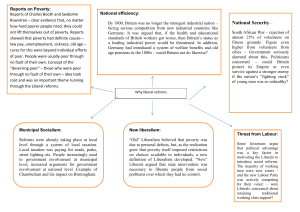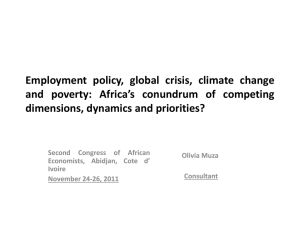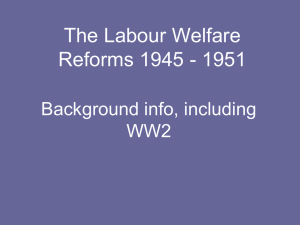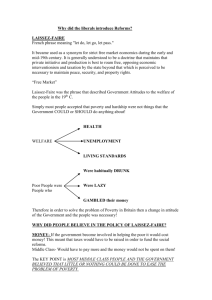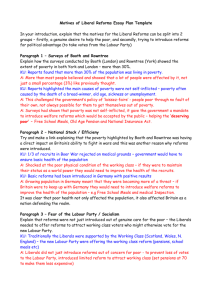From the cradle to the grave, social welfare in Britain 1890s-1951
advertisement
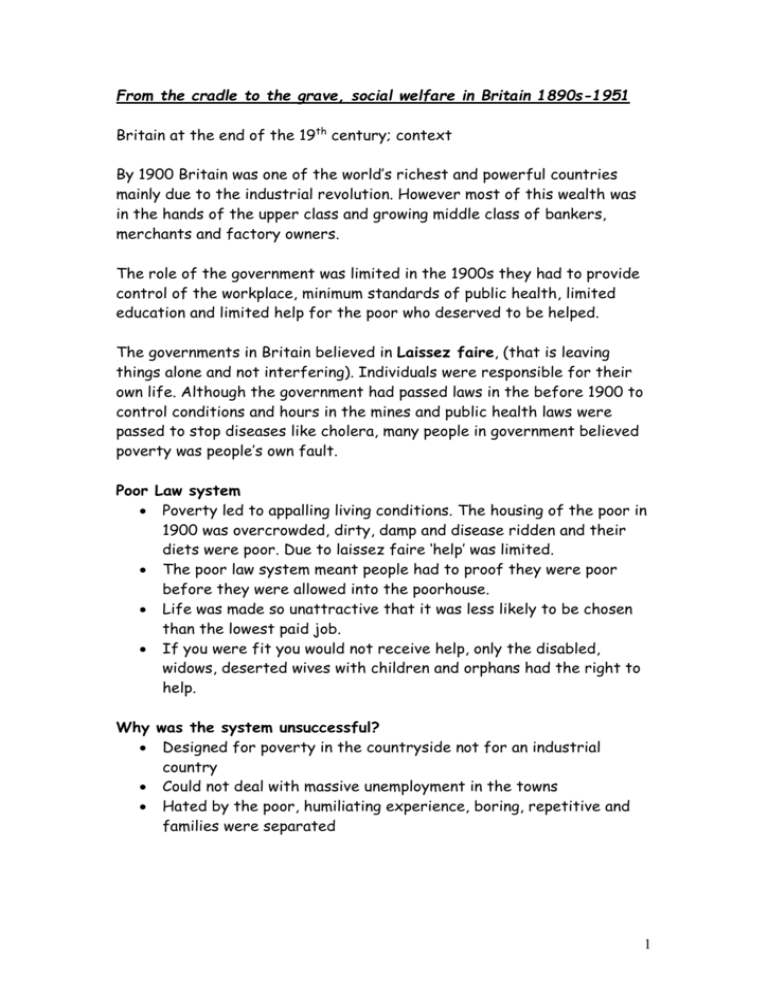
From the cradle to the grave, social welfare in Britain 1890s-1951 Britain at the end of the 19th century; context By 1900 Britain was one of the world’s richest and powerful countries mainly due to the industrial revolution. However most of this wealth was in the hands of the upper class and growing middle class of bankers, merchants and factory owners. The role of the government was limited in the 1900s they had to provide control of the workplace, minimum standards of public health, limited education and limited help for the poor who deserved to be helped. The governments in Britain believed in Laissez faire, (that is leaving things alone and not interfering). Individuals were responsible for their own life. Although the government had passed laws in the before 1900 to control conditions and hours in the mines and public health laws were passed to stop diseases like cholera, many people in government believed poverty was people’s own fault. Poor Law system Poverty led to appalling living conditions. The housing of the poor in 1900 was overcrowded, dirty, damp and disease ridden and their diets were poor. Due to laissez faire ‘help’ was limited. The poor law system meant people had to proof they were poor before they were allowed into the poorhouse. Life was made so unattractive that it was less likely to be chosen than the lowest paid job. If you were fit you would not receive help, only the disabled, widows, deserted wives with children and orphans had the right to help. Why was the system unsuccessful? Designed for poverty in the countryside not for an industrial country Could not deal with massive unemployment in the towns Hated by the poor, humiliating experience, boring, repetitive and families were separated 1 Self help This was the idea that people could get themselves out of poverty if they worked hard. Samuel Smiles published a book in 1859 called self-help; his ideas were very popular in Britain. He warned against government helping people too much as it made them helpless. Smiles argued that the average worker could avoid poverty by working hard and saving some of their wages. Those who did not look after themselves were lazy, unable or unwilling to save or drunks. What self help was there? Friendly societies allowed workers who had a regular income to pay in contributions which meant they could receive benefits when they were sick, had an accident or old age Savings banks were popular with servants and those who were saving for their children. ‘Penny savings banks’ allowed the very poor to save Co-operative movements involved communities to get together to provide low cost food and services e.g. grocery store Criticisms of self-help not every one could afford to save e.g. Henry Mayhew in his study of London labour and the London Poor (1861) identified that casual labourers were unable to save lack of education and poor health also stopped many people improving their lives. Voluntary aid: Charity Usually the first place people looked for help was from relatives e.g. looking after children, giving food or clothes that their children had grown out of. However if this was not enough, people had to depend on the help of charitable organisations. Charities provided a range of help money expertise time 2 By the 1860s there were so many different groups and insufficient help that they organised themselves to co-ordinate effort. Most of these societies would only help the ‘deserving poor’. Many of these charities still exist today e.g. RSPCA, Dr Barnardo’s, Salvation Army, Quarrier’s. Why were charities run? Mainly run by middle class women and men who feared the poor rising up against the wealthy, charity could stop this Genuine concern, Christian concern for the poor e.g. William Booth formed the Salvation Army Opportunity for middle class women to get involved outside the home Wanted to help the poor lead a ‘better life’ Many believed poverty was caused by the poor themselves, believed in Smile’s ideas, they therefore wanted to educate the poor e.g. Octavia Hill Importance of charities Existence of so many charities was evidence that not everybody could help themselves and escape poverty No means clear that the only cause of poverty was the person who was poor Changing attitudes to poverty Books like Andrew Mearns, The bitter cry of Outcast London, an enquiry into the Conditions of the Abject poor in 1883, Charles Booth and Seebohm Rowntree’s studies into poverty shocked the wealthy Victorians. Charles Booth Liverpool ship owner who originally believed that if people were poor it was their own fault. Between 1889 and 1903 he studied the life of the poor in London His findings ‘Life and Labour of the people in London’ changed his opinion and he concluded that 30% of London’s population was living in poverty He used scientific methods and put people in classes, he worked out a ‘poverty line’ a level of income required to stay beyond starvation The scale of poverty he discovered could not be met by charity alone 3 Seebohm Rowntree Member of the wealthy family Rowntree’s chocolate factory. He decided to conduct his own research in York to compare Booth’s findings. His book Poverty, A study of Town Life found similarities to those of Booth Showed poverty was widespread, one third of the population living in towns lived in poverty Primary poverty was used to describe those whose earnings were low but could survive on this (15%), secondary poverty was used to describe those whose earnings were enough but who spent their money in a wasteful way (18%) These investigations found poverty was not the persons fault Many of the elderly, ill and unemployed lived poor lives and workers wages were so low they could not afford the basics. The Boer war The Boer war broke out in 1899 between British Empire and the Boer Republicans (Dutch settlers) in South Africa. Britain thought the war would be over quickly but Boer troops were well trained and equipped and it dragged on for 3 years. 400,000 British troops were sent eventually to defeat the Boers. Why did the Boer war highlight poverty? Performed badly in war, 3 years to defeat Boers 9 out of 10 recruits were rejected as they were unfit, this would have implications for defending the empire in the future Implied an unfit workforce as well as an unfit army 1903 the Committee on Physical Deterioration was set up to investigate, in 1904 it reported no long-term physical deterioration of the population, but many made recommendations including medical inspections of children in schools, free school meals and training in mother craft. 4 Democratic developments By 1890 the majority of people voting were members of the working class. 6 out of 10 had the vote. This meant the working class could now elect people who wanted to change the way Britain was run. Trade Unionism Between 1892 and 1900 membership of TU’s had grown from 1.6 million to just over 2 million members. Skilled and semi-skilled workers were now represented and there were strikes and lockouts. This led unions to look to Parliament to protect them from unemployment and employers. It also led to the creation of the Labour party. Spread of Socialism Socialists argued that the government should interfere more with the way the country was organised and to help the poor. The growth of the labour party and socialist thinking pressurised the Liberal Party by threatening to take away the support of the working class. Liberals had supported the theories of self-help and laissez faire. However new liberals argued that this was not working and that the state had to take a role in improving standards of living. It was the Liberal Party that would begin to tackle the huge problem of poverty. 5 The Liberal Government, 1906-14 In 1906 the Liberal Party won a huge majority in Parliament. The party was led firstly by Henry Campbell Bannermann, then from 1908 Henry Asquith. The new liberals, Winston Churchill and David Lloyd George were willing to use the power of the state to intervene and end poverty. The Liberal Reforms: Children Meals for children, the Education (provision of meals) Act, 1906 Why Boer war and poor condition of recruits Healthy children would become healthy soldiers The British empire would be stronger The Act Allowed local authorities to provide school meals for poor children Allowed local authorities to raise a local tax to pay for this Children from better off families were expected to pay Problems Act was voluntary which meant that many local authorities chose not to provide food By 1913 over half (England and Wales) had not begun to provide meals Money was the problem, government provided money in 1914 to meet half the costs Importance Feeding the children rather than their families, challenged idea of self-help More children than expected given free school meal as difficult to make parents pay and identify who deserved a free meal Medical Inspections for Children, 1907 Why Need for a healthy Britain Recommended by board in 1904 6 The act Provided treatment for illnesses and many clinics were introduced into school to provide treatment Government provided help to pay for these clinics in 1912 as again they were not compulsive for local authorities Importance Another step taken to provide for children Self-help theory attacked Step towards greater healthcare for all However only identified problem did not cure it The Children’s Charter, 1908 Why Creation of Herbert Samuel, Liberal MP brought together previous laws such as Prevention of Cruelty to Children’s Act and produced one law Stated what the legal rights of children were The Act If children were not cared for by their parents, the government should care for them Children banned form buying cigarettes under age of 16, and not allowed in pubs under 14, forbidden to give alcohol to children under 5 except in illness Inspections of children’s homes Fires to be guarded as 1,000 children burnt to death every year Child criminals to be sent to juvenile courts and borstal system rather than prison Death sentence abolished for children Importance Protected children from abuse and covered many other aspects of life for children. Children’s rights regulated by the state, self-help challenged 7 The Elderly and Old Age Pensions (1908) Why Booth and Rowntree had shown how much poverty was due to old age, they could not afford to save when they were working Royal Commission on the age poor, 1895 provided evidence to support introduction of pensions New Zealand and Germany had introduced pensions in 1906 Pressure from Labour Party and TU’s as they supported pensions, Liberals were losing seats by 1908 to the Labour Party in byelections, therefore they wanted to encourage working class to vote Liberal in the future The Act No contribution necessary, to be paid from taxation and paid through the Post office removing the stigma of the poor law Paid to people over 70 5 shillings at full rate a week for a single person, 10 shillings a week for a married couple savings had to be used to provide an income, so amount paid varied Importance No contributions necessary, therefore self-help challenged More people claimed as people not branded poor but instead discreetly collected for post office Made a real difference although not enough to live on alone, topped up their income Problems Demand higher than expected, cost estimated at £6.5 million, actual cost was £8 million, this meant the government had to find the extra money Limited to over 70s Health; Part 1 of the National Insurance Act of 1911 Lloyd George wanted to help those who became poor through ill health and unemployment. Bad health cost many workers their jobs and often their lives. 8 Why The insurance scheme planned allowed employer, employee and state to contribute to a fund of money when the worker was employed When the worker was ill or unemployed money was paid out for a limited period of time Insurance meant the cost of reform was not too expensive for the government Workers contributed for their own care making the scheme ‘respectable’ Workers would hopefully vote for the Liberal Party The Act Employers contributed 4d a week if they earned under £160 a year, employers contributed 3d a week, the state contributed 2d a week It gave workers ‘9d for 3d’ Insured workers were entitled to 10 shillings a week for 13 weeks and 5 shillings for another 13 weeks if ill Entitled to free medical treatment and 30 shillings maternity benefit for the birth of each child Problems Opposition from friendly societies who ran schemes for workers, TU’s who objected to men contributing to the reform and Private insurance companies e.g. Prudential who were threatened by the scheme After using 26 week entitlement, ill workers had to rely on poor law medical facilities Families did not receive benefits if they fell ill only workers Self employed and unemployed not covered Importance State extended role to help poor, this was a compulsory Act Many workers were angry that they were forced to contribute as it reduced their pay packet, Liberals did not make the political gains they had hoped for 9 The 1911 National Insurance Act Part II; Unemployment Benefit Why See notes under health The Act Employees contributed 2 ½ d per week, employers 2 ½ d per week, the state 1 2/3 d per week The benefit was 7 shillings a week for up to 15 weeks of unemployment A weeks benefit was paid, for every 5 weeks contributions made and was administered through the Labour Exchanges Problems No cover for rest of family only worker Limited cover once entitlement was used up the Poor law had to be used Applied to limited industries e.g. building, construction, shipbuilding, mechanical engineering etc these workers were normally employed for short periods of time then were unemployed when the work finished Original scheme, no scheme like this in other countries Undermined idea of self-help, no distinction between deserving and undeserving poor Recognised complex problems of unemployment Employment reforms The government also tried to improve the conditions for workers who were employed regularly. 1908 Mines Act Limited time that a miner could work, to 8 hours a day 1909 Trade Boards Act Boards were established in ‘sweated trades’ such as tailoring These trades had long hours and poor pay, minimum wages were negotiated 10 1911 Shops Act Limited working hours of shop workers to 60 hours a week Shops had to close one day a week to give time off Labour exchange Act, 1908 Short-term unemployment was also a concern. Many workers had employment but only for a short time. Between these times they often had no money to live on as they could not save. These workers were not covered by insurance schemes run by the friendly societies. The Act By 1910 there were 83 labour exchanges The idea was that unemployed workers could go there to find work, employers would also go to these exchanges to find the workers they required By 1911 there were 414 exchanges Problems Scheme was voluntary Employers did not have to tell the exchanges they had vacancies Workers did not have to register with the exchanges if they were out of work An answer to poverty? Look at each act and then the problems to make an evaluation Historians disagree, View 1; liberal reforms were the starting point for reforms in the future, the laid the foundations of the welfare state that was completed under Labour View 2; limited in their aims e.g. did not tackle the problem of housing or education, widow and orphans not helped. More reform was required. The First World War and inter-war years What progress was made during the First World War? 3 out of 9 recruits were fully fit to fight, rationing was set up to ensure everyone got a fair deal by the end of the war plans were in place to carry out important welfare reforms 11 Why did Post-War Welfare Plans Fail? 1918 election produced a joint government between the Liberals and the Conservatives therefore Lloyd George was not free to do what he wanted Unemployment was high and from the 1920s Britain’s economy had a depression, not enough jobs were created in new industries e.g. cars instead Britain was reliant on old industries such as shipbuilding Therefore the government decided to keep government spending down and this meant no money for reforms, there were also 5 different governments between 1918 and 1929. In 1929 after the Wall Street crash in America, there was high unemployment in Britain, which increased the level of poverty. In 1929 Ramsay MacDonald, Prime Minister, appointed a committee to deal with the crisis. It reported that cuts in spending and wages of civil servants and cuts in unemployment benefit would help. This led to a split in the Labour Party and a National Government was set up. Unemployment benefit was reduced by 10% and the ‘means test’ was used after 26 weeks. The cuts were restored in 1934 The 1934 unemployment Act set up two national boards, one to take care of those who had paid contributions and the other for those who had not. Government training centres were set up and ‘special areas’ to encourage investment. However these special areas were not attractive to new firms and therefore did not guarantee jobs. What progress had been made by 1939? Realisation by government that it was not enough to react to crisis Renewed growth in charities who worked in partnership with the government Availability of help was extended e.g. housing and education Growing awareness of the social neglect and division in British society. The effects of the Second World War When war broke out in 1939 it was clear that the war was not going to be short. The war united communities and many people found out about social problems for the first time. This and people’s suffering in the war made people determined to create a better world after the war. 12 Key figures Winston Churchill replaced Neville Chamberlain as Prime Minister. His government included all the main parties- coalition government. Clement Atlee was deputy Prime Minister Ernest Bevin was Minister of Labour Arthur Greenwood, Herbert Morrison and Stafford Cripps were all given key posts. This was a chance for the Labour Party to gain experience. Evacuation ‘The bomber would always get through’ this fear led to the organised moving of children to the countryside. The condition of some of the children was a shock to middle class country dwellers this raised awareness of social problems which many assumed to have disappeared Different section of society met up and socialised with each other in a way unheard of peacetime The bombing Key factories and communication links were bombed by the Germans, as well as big industrial town including Aberdeen, Glasgow, Edinburgh and Dundee Very often the bombers missed their targets and dropped their bombs before they went home, the bombers destroyed the homes of rich and poor Again this brought people together who normally had little to do with each other e.g. sheltering in subway stations, this helped raise awareness of the level of poverty Rationing As Britain depended on imports (60%) for food their food supplies dropped This caused queuing and rising prices, which meant only the rich could pay the high prices, to ensure ‘fair share for all’ the government introduced food rationing in 1940 and clothes rationing in 1941 This helped to establish the idea of universal and equal share of the ‘national cake’ as rich and poor were fighting the war, conscription introduced young men in the armed services and women were conscripted either on the home front or war front. 13 Government also took more control of the nations health The Ministry of Food under Lord Woolton, ensured everyone got a fair share of the food, it also aimed to improve the nation’s health in order to improve the ability to fight, calcium, iron, minerals and vitamins were added to certain foods A series of ‘food fact’ leaflets with nutritional information were produced and cookery demonstrations took place nation-wide The Ministry of Food was important for promoting the nation’s health and was the first attempt to apply nutritional knowledge. To what extent did the Second World War cause the Welfare State? See notes from effects of WW2 Suffering made people determined to create a better society after the war Shared experiences, evacuation, bombing, rationing led to more awareness of poverty The government took a greater role in helping people and the public expected them to do more Pressure to rebuild Britain led to Churchill’s government drawing up plans to tackle the ‘five giants’ The Beveridge Report and the ‘five giants’ What were the five giants Beveridge believed Want, disease, ignorance, squalor and idleness stood in the way of social progress To fight these giants a proper system of sickness and unemployment benefit was needed, a proper national health service, family allowance and a full employment policy. His ideas provided the basis for the ‘welfare state’, he believed all the problems would have to be solved to improve the welfare of British citizens Main points in Beveridge report Government minister to be appointed to control all the benefits schemes National Health Service should be set up Weekly National Insurance Contributions to be made by people in work and unemployed to have the right to payments for an indefinite period, no means test 14 Benefits to include Old Age Pensions, maternity grants, pensions for widows and people injured at work, family allowance The scheme was to be universal, applied to everyone and people were entitled to benefits. It had revolutionary ideas- society should tackle five giants of poverty Coalition government under Churchill Labour Party credited for putting Beveridge Report into action but coalition government made a start 1943 ministry to supervise insurance benefits was set up 1945 Family Allowance Act was passed, benefits not as generous as Beveridge had proposed, payments delayed for a year Ministry of Town and County Planning set up in 1943, new towns were planned, temporary housing built for homeless White papers published (future action) on the National health service, employment policy and social insurance but nothing radical with the exception of education as concentrating on war Education reform under coalition government Three stages of educational development; Primary, secondary and further to be provided by local authorities Free education for all, fees abolished for local authority schools although not grammar schools Leaving age set at 15 from 1945 Criticisms Two-tier system crated, grammar school pupils could expect to go to university a secondary modern pupil would do practical subjects and go onto a trade. Young people from poorer backgrounds were discriminated Election of 1945 People wanted a reward for all their suffering during the war Policies of two main parties, Conservatives and Labour not very different, but electorate trusted Labour more. They won with 393 seats compared to the Conservative’s 213 People had remembered the promises after WW1 which had not been delivered by the Conservatives or Liberals Labour had consistently supported social reforms whereas the Conservatives had favoured cuts during depression 15 Churchill not as enthusiastic about Beveridge report, worried about the cost involved Churchill campaigned on heavy spending for defence rather than domestic spending Labour government and the welfare state How did they pay for the reforms? By 1948 the Labour government had set up most of the services that made up the welfare state. Money was raised by nationalising industries e.g. coal, gas, railways, electricity, airways, Bank of England to help control the economy Rationing continued on food, furl and clothing Further Loan from America and ‘Marshall Aid’ from America to help fight Communism Labour reforms The National Insurance Act, 1946 Benefits were set up for unemployment, sickness, maternity and widows Allowances were paid to parents in charge of children Retirement pensions were paid Death grant given to assist with funeral expenses Rates of benefit; 26 shillings a week basic rate, 42 shillings for a married man, 7s 6d for first child Industrial Injuries Act, 1946 Payments for these temporarily hurt in an accident Long term payments for anyone permanently unable to work, this group also got a higher rate of benefit than someone out of work National assistance board In 1948 a National assistance board was set up to help people not covered by the National Insurance Act People had to undergo a ‘needs test’ and an interviewing process to assess genuine need Provided weekly or one-off payments for bedding or clothing 16 Nationalisation Committed to full employment, the Labour government nationalised many key industries (see previous page) This kept unemployment low (below 3%) but many industries were badly run and cost the government money e.g. coal mining National Health Service, 1946 Problems Setting up of Health service Bevan’s biggest problem was getting the co-operation of the doctors and dentists, they were worried that they would become government workers, the service was therefore delayed for 2 years Many hospital workers were in favour of the health reforms as the hospitals required modernising, the real opposition came from GPs who felt they would lose the freedom to treat a patient as he wished, they began a fierce campaign Bevan had to promise new equipment and buildings, he also agreed that doctors could continue to treat private as well as Health Service patients. Also doctors would get a salary and be able to earn money by treating private patients, each hospital had pay beds for people wanting private treatment This left the GP’s isolated by 1948 Bevan had persuaded a quarter of GPs in England and a third in Scotland and Wales to sign up for the NHS. The NHS started working in July 1948 People now had access to basic health services free of charge Problems with NHS High demand for services, demand outstripped government estimates, cost of prescriptions doubled after July 1948, the same with dentists and opticians Funding became a real problem, NHS contributions only paid for about 10% of the service costs, the rest was met with taxation Prescription charges had to be introduced in 1951, Bevan resigned in protest 17 Housing How did they cope with the housing shortage? Many homes had been destroyed during the war and slum housing still existed The priority was to house the homeless, ‘pre-fabricated’ or ready made houses continued to be put up, these were supposed to be temporary but many still exist today Private house building was restricted so building supplies and labour could be used for council housing The 1946 New Towns Act tried to solve the problem of overcrowding in the cities by planning new communities The 1947 Housing Town and Country Planning Act gave councils more planning powers and the ability to buy property in areas they wanted to re-develop 1949 Housing Act. Local Authorities were allowed to buy homes for improvement or conversion, grants were available for home improvements Did the government meet the Housing needs? Made progress with housing problem but still huge shortages Demand was so great that quantity rather than quality became the priority Shortage of building materials led to problems Education, 1947 Butler Education Act Planned expansion in further education, student places increased and grants system was set up to assist children from poorer backgrounds Leaving age increased to 16 Children’s Act, 1948 meant local authorities had to appoint children’s officers to ensure decent care for children under authority supervision 18 Summary of welfare reforms: success? Want successes; The National Insurance, Industrial Injuries and National Assistance Acts meant everyone would be given help ‘from the cradle to the grave’ Want problems; Needed many people to administer scheme Not everyone covered by the National Insurance Act, only those with a certain level of contributions, ‘safety net’ did not cover everyone Disease successes; National health Service Act, 1946 gave free medical, dental and eye services to all Huge improvement for British citizens Disease problems; Hospitals were old and not suitable for modern health care, financial pressures meant old hospitals were not replaced until 1960s So many people used service that it became too expensive for the government to fund, charges were introduced in 1951 for prescriptions Housing successes; Building encouraged by keeping down the prices of building goods and labour New towns planned and home owners encouraged to make improvements by applying for a grant 200,000 houses built between 1948-51 made real progress Housing problems; level of house building does not compare well with 1930s or 50s many houses built were prefabs-temporary, shortage of materials still shortages families forced to squat in London, aerodromes had to be used (military housing), not enough housing for ex service people 19 education successes; raised school leaving age to 16, definition of stages of school school building programmes education problems; limited for a socialist party, few working class children had the chance to go to an academic school, divisional education system school building programme concentrated on primary schools to cope with ‘baby boom’ only 250 secondary schools built by 1950s Idleness successes; policy of full employment promoted, nationalised industries Unemployment 2.5% below the target of 3% Idleness problems; British economy and jobs depended heavily on loans from America women were replaced by the men returning from the war, many were happy to go back to being a house wife others found themselves excluded from the jobs they would have liked to continue doing. Success or failure Historians disagree View 1; poverty was not abolished but it was reduced, system of universal social insurance provided a welfare state. View 2; crushed individual responsibility and created dependency on the state, cost was a burden the government miscalculated the cost of the NHS, failed to address housing and education needs fully. 20 From the cradle to the grave, social welfare in Britain 1890s-1951 21
